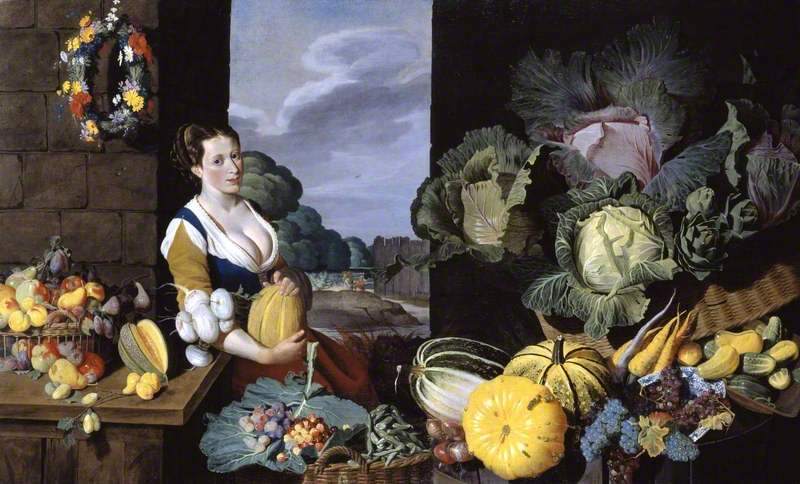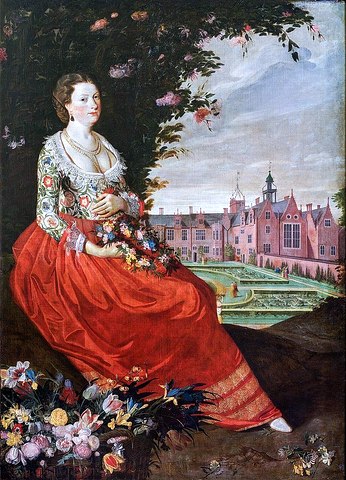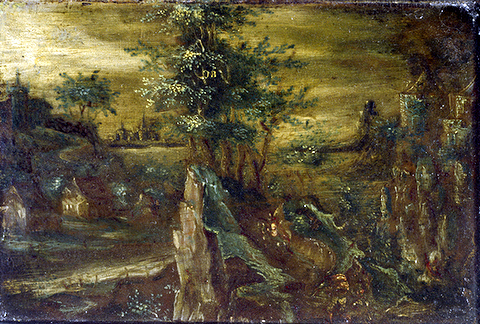BACON, Sir Nathaniel
Nathaniel Bacon was born at Redgrave, Suffolk in August 1585, the grandson of Lord Keeper Bacon (1510–1579) and the youngest son of Sir Nicholas Bacon (c.1543-1624), subsequently the premier baronet of England, and his wife, Anne née Butts (c.1547–1616). Nathaniel was raised at Redgrave Hall and to mark the coronation of King Charles 1, admitted to the Order of the Bath in February 1626. On his marriage to Jane, née Meautys (1580/81–1659), widow of Sir William Cornwallis, on 1 May 1614, Bacon acquired Brome Hall, Suffolk and later inherited Culford Hall, 4 miles north of Bury St Edmund’s, from his parents. Bacon has been described as ‘the most accomplished [British] amateur painter of the [seventeenth] century’, although fewer than a dozen of his works survive, several of which are self-portraits. The earliest documentary reference to specific pictures is in the inventory of Culford attached to his widow's will of 1659, which mentions ‘Ten great peeces in wainscoate of fish and fowle &c. done by Sr: Nath: Bacon’. The 'Cookmaid with Still Life of Birds', still in the possession of the artist's descendants, is thought to be one of these, as are the 'Cookmaid with Still Life of Game', acquired by the family in the 1950s, and the Tate collection's 'Cookmaid with Still Life of Vegetables and Fruit', all executed around 1620 to 1625. A tiny landscape, painted on copper, bearing the conjoined monogram NB (Ashmolean Museum, Oxford), is thought to be the ‘small Landskip drawn by Sir Nath. Bacon’ listed in the Tradescant Collection in 1656 (Musaeum Tradescantianum, 1656, 40). The Antwerp artist Frans Snyders (1579-1657) was a major exponent of the genre, and Bacon visited that city in 1613. As a gentleman, Bacon had no need to paint for his living, but his art was clearly significant to him and his funerary monument in St Mary's Church, Culford, Suffolk bears two carved painter's palettes. In 1622 Henry Peacham (1578-c.1644) commended him as a well-born Englishman who could draw and paint, while Edward Norgate (1581-1650) credited Bacon with inventing a particular ‘Pinke’ (i.e. yellow) used by other artists, such as Peter Oliver (1589-1647) and John Hoskins (c.1590-1665). Nathaniel Bacon died in June 1627 and was buried at St Mary's church, Culford, on 1 July 1627. The record of his funeral states that he died of ‘a lingering illness’, and letters indicate a decline in health from about 1622. Of his three children only Anne (b. 1615), who married, secondly, Sir Harbottle Grimston (1603-1685), had any children. [Nathaniel Bacon: Artist, Gentleman and Gardener by Karen Hearn (2006)]
Works by This Artist

|
Cookmaid with Still Life of Vegetables and FruitOil on canvas
|

|
The Artist’s wife, Jane Bacon, Lady Cornwallis, née MeautysOil on canvas
|

|
The Small LandskipOil on canvas
|